Underground Utilities Survey – PAS128
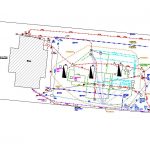 It is vital that all buried services be identified before any invasive site investigation work is carried out. The first stage will usually be to obtain all relevant drawings for utility providers, and we offer a fast, reliable service for this.
It is vital that all buried services be identified before any invasive site investigation work is carried out. The first stage will usually be to obtain all relevant drawings for utility providers, and we offer a fast, reliable service for this.
We also carry out detailed site surveys using active and passive radio detection supplemented by ground probing radar, with results provided in CAD format. All our surveys conform to PAS128 standard.
Topographic Survey
We offer 2D or 3D topographic surveying, with all results provided in CAD format.
CBR Testing
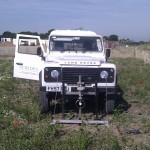 California Bearing Ratio tests are used to determine the relative density of imported fill material, usually for roadways ro pavements.
California Bearing Ratio tests are used to determine the relative density of imported fill material, usually for roadways ro pavements.
We typically carry out the test using our Land Rover as kentledge and typically complete 6-8 tests per day, with results issued to you the same day.
Please note that CBR testing is only suitable for aggregates with a size less than 20mm. A plate bearing test should be used to test fill material that is coarser than this.
Plate Bearing Testing (PBT)
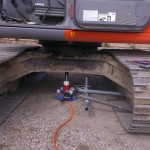 Plate bearing tests are most commonly used to assess the suitability of ground for either temporary foundations (e.g. for site accommodation) or for siting crane outriggers. We can also use a PBT to determine the CBR value for the ground. We typically complete 6-8 tests per day with results issued to you the same day. If you are able to provide loading requirements (e.g. the crane outrigger load) then our test certificate will include a factor of safety against this loading.
Plate bearing tests are most commonly used to assess the suitability of ground for either temporary foundations (e.g. for site accommodation) or for siting crane outriggers. We can also use a PBT to determine the CBR value for the ground. We typically complete 6-8 tests per day with results issued to you the same day. If you are able to provide loading requirements (e.g. the crane outrigger load) then our test certificate will include a factor of safety against this loading.
Note: The test requires a minimum 7t, and preferably 13t, tracked excavator for us to use as kentledge. If this is not available on site then we can usually provide this.
Clegg Hammer/Dynamic Cone Penetration Testing
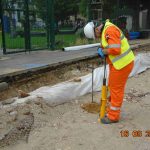 The Clegg Impact Hammer provides a very rapid means of measuring the CBR value for rolled aggregates or for engineered surfaces such as a tennis court sub-base. We typically complete 50+ tests in a single day, with results issued to you the same day.
The Clegg Impact Hammer provides a very rapid means of measuring the CBR value for rolled aggregates or for engineered surfaces such as a tennis court sub-base. We typically complete 50+ tests in a single day, with results issued to you the same day.
Just as with CBR testing, the Clegg Hammer is only suitable for testing fine aggregates. The test is less accurate than a CBR test and is best suited to identifying soft spots across a site rather than for confirming whether a backfill specification has been satisfied.
The Dynamic Cone Penetration test also provides a rapid means of obtaining a CBR value for a sub-base or piling mat down to a depth of 1m . The test kit is hand-portable and doesn’t require any additional plant or vehicle to act as kentledge. The test is applicable to fine aggregates. We typically complete 20+ tests in a day, with results issued to you the same day. This allows soft spots to be easily identified, rectified and, if necessary retested.
Dynamic Probing
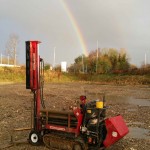 Dynamic probing is a useful test for quickly and cheaply determining the relative strength of soil strata under a site or for identifying the depth to a particular founding layer across a site. We use our Terrier rig with its calibrated hammer system for all our dynamic probing. Mounted on tracks, this is able to access even the most challenging of terrain.
Dynamic probing is a useful test for quickly and cheaply determining the relative strength of soil strata under a site or for identifying the depth to a particular founding layer across a site. We use our Terrier rig with its calibrated hammer system for all our dynamic probing. Mounted on tracks, this is able to access even the most challenging of terrain.
We typically can complete a 20+ locations each day, probing to 10m+ depth, and with results reported as a graph of equivalent SPT ‘N’ value versus depth
Pile Probing
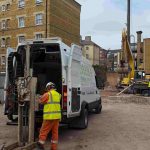 Pile probing has become increasingly popular in the last few years. Checking proposed pile locations for obstructions and/or voids before the piling rig arrives on site allows piles to be relocated and ground beams to be redesigned without delaying the project or uncurring expensive standing time charges.
Pile probing has become increasingly popular in the last few years. Checking proposed pile locations for obstructions and/or voids before the piling rig arrives on site allows piles to be relocated and ground beams to be redesigned without delaying the project or uncurring expensive standing time charges.
We use our MkII Geoprobe rig to carry out most of our pile probing work, with 200 liner metres of probing typically completed each day. The rig is permanently mounted in a 2WD Iveco panel van and can be rapidly deployed to each pile location. The rig’s built-in concrete breaker allows us to make a 75mm diameter hole through any concrete paving or floor slab, before driving a 50mm diameter probe to the required depth.
We can use the same rig to carry out probing for UXO, thus avoiding duplicate costs being incurred.
UXO Surveys
Until recently intrusive UXO (unexploded ordnance) surveys were both slow and expensive. However, we have developed a rapid, low cost method for carrying out UXO surveys using our Geoprobe Direct Push drilling system. We drive a specially designed probe containing a magnetometer into the ground. This continuously scans the ground beneath and around the probe, giving advance warning of any ferro-magnetic material such as bomb or shell casings.
We also carry out UXO risk assessments/desk studies and provide UXO site supervision.
Soakaway Testing
The pressure to building new housing seems to be constantly in the news these days. Developers working to meet this demand are increasingly finding that they are required to find sustainable methods for disposing of the rainwater from roofs and paved areas. The days when this could just be discharged to the municipal sewer are long gone. Instead, wherever possible, the water must be disposed of into the ground via soakaways or other similar ‘infiltration features’. Designing these requires careful measurement of soil permeability. We offer a comprehensive range of testing methods, from hand-dug percolation tests for Sustainable Drainage Systems (SUDS – NHBC Chapter 5.3) to machine-dug test pits for full scale soakaway tests (BRE 365). If site access is limited we can even carry out the requisite testing in boreholes drilled as part of our geotechnical/environmental investigation of the site.
